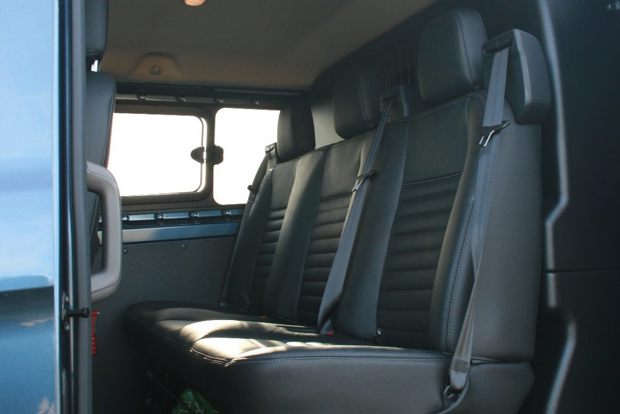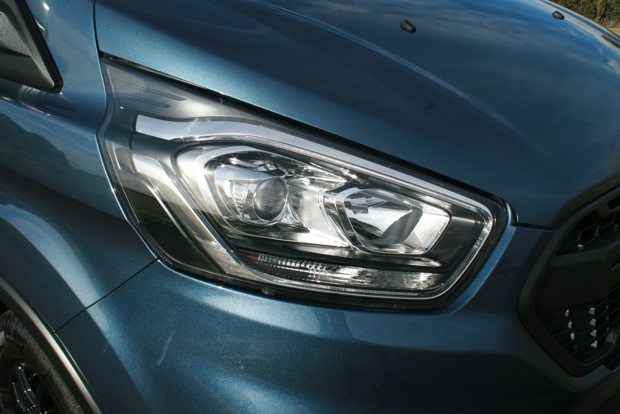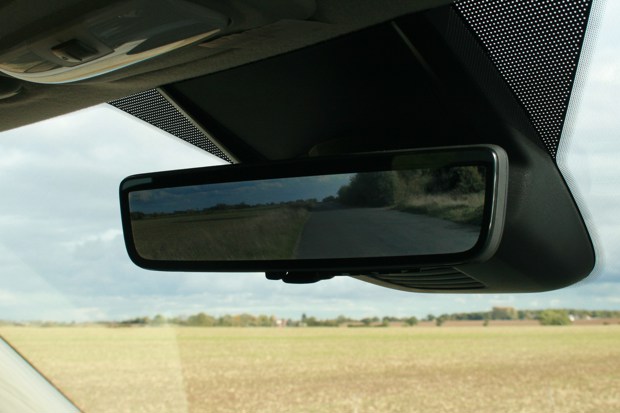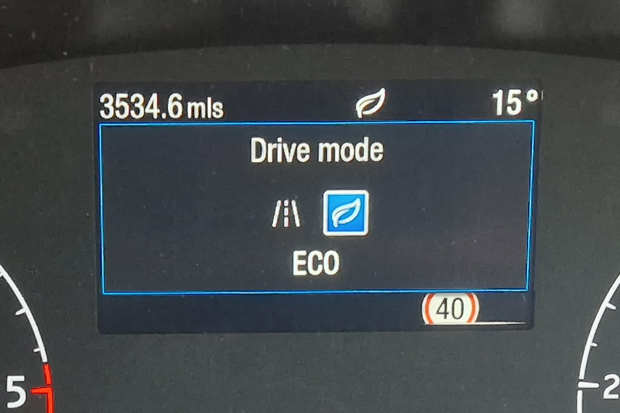Ford Transit Custom Trail

Specifications: Ford Transit Custom Trail
- Run by: Dan Powell since October 2022
- Price when new: £45,438 (£47,994 including options)
- Engine: 2.0-litre diesel
- Power: 170PS
- Torque: 390Nm
- Claimed economy: 36.7mpg
- CO2 emissions: 201g/km
- Insurance group: 41
- Report 1: We welcome our new Transit Custom van
- Report 2: Which engine is best in the Ford Transit Custom?
- Report 3: Can you upgrade the Ford Transit Custom's headlights?
- Report 4: What are the best van gadgets and tech?
- Report 5: What are the internal dimensions of the Ford Transit Custom Trail?
- Report 6: What does Eco Mode do on the Ford Transit Custom?
- Report 7: Side window problems with the Ford Transit Custom
Report 1: We welcome our new Transit Custom van
Are you looking for family-friendly transport with five seats and lots of storage? The Ford Transit Custom Trail might be a van but it's well worth considering.

Date: 13 October 2022 | Current mileage: 819 | Claimed economy: 36.7mpg | Actual economy: 40.8mpg
pacious, versatile and surprisingly easy to live with, the modern van is the Swiss Army Knife of the automotive world. It is also one of the best family cars that you've probably never heard of, with a huge choice of models and body-styles that include the panel van, camper and the family-friendly double cab and kombi.
Since moving to Devon in 2021, I've discovered that almost everyone here drives a family van. They are particularly popular with drivers who need a practical vehicle with low running costs for carrying surfboards, kayaks or mountain bikes. And being a keen trail runner and cyclist, I've decided to join them with a six-month review of the Ford Transit Custom Trail Double Cab-in-van.
My short wheelbase Ford Transit Custom is a five-seater model that features two rows of seats and a pair of extra windows. It also has 5.3 cubic metres of loadspace, separated from the passenger space by a full-height steel bulkhead.
The Trail model of the Transit Custom is the outdoorsy version of Ford's best-selling panel van with lots of plastic body protection. It also uses the same front grille as the Ranger Raptor pick-up, while its limited slip differential should provide extra grip on wet or slippery surfaces.
We've added the optional blue metallic paint (£780), a digital rear view camera (£300) and a power point plug (£72). Our long-term test vehicle also has heated front seats with lumbar support (£360) and the ICE Feature Pack 25 that adds touchscreen navigation, adaptive cruise control, emergency assistance and steering wheel radio controls (£912).
Weighing in at £47,994 (including VAT) this Ford Transit Custom Trail rivals some of the best SUVs on price. It also matches the larger ones in size, with the short wheelbase and low roof (L1H1) Transit Custom being 2272mm wide (including mirrors), 4973mm in length and 2000mm high.
Powered by the 170PS version of Ford's 2.0-litre EcoBlue diesel engine, this Transit Custom Trail is advertised as achieving 36.7mpg combined. However, since it was delivered two weeks ago, I’ve averaged around 40mpg over the first 800 miles - not bad at all. Will this van earn its stripes as a class-leading family car? We’ll find out over the next six months.
Report 2: Which engine is best in the Ford Transit Custom?
The 2.0-litre EcoBlue diesel engine in the Ford Transit Custom can be a real peach, thanks to its punchy low-gear acceleration and affordable running costs. But which version of the diesel engine in the Ford Transit Custom is best?

Date: 27 October 2022 | Current mileage: 1305 | Claimed economy: 36.7mpg | Actual economy: 40.7mpg
The answer to that question will very much depend on what you plan to do with your family van. The Ford Transit Custom is offered with just a single engine - Ford's trusty 2.0-litre turbodiesel. Power outputs for this four-cylinder diesel are 105PS, 130PS, 170PS or 185PS.
The entry-level 105PS 2.0 diesel will probably be too light on power for most people, with its 310Nm of torque making the Transit Custom feel somewhat sluggish when pulling away from a busy junction or roundabout. The 130PS engine on the other hand is a really good option. On paper, it doesn't appear to have much more in the way of power than the 105PS engine, but on the road it feels far superior thanks to its extra 50Nm of torque.
If you plan to utilise the full carrying capacity of your family van then I'd suggest the 170PS version of the 2.0-litre EcoBlue diesel (as tested here). You get 390Nm of torque, which provides rapid and smooth acceleration. If you feel you need more power, there is a range-topping 185PS/415Nm engine, too.
When it comes to advertised fuel economy, there really isn't a great deal between the four versions of the 2.0-litre engine, with most of them ranging between 35-40mpg. The only exception to this is the 170PS and 185PS versions when paired with the six-speed automatic, with both returning an official 31.7mpg.
Since clocking up my first 1300 miles, I've been impressed with the 40mpg that I've been averaging with a mixture of long motorway runs and shorter local trips. The six-speed manual gearbox works well with the front-wheel drive Transit Custom and the torque-heavy output of the 170PS engine allows you to sit in fifth or sixth gear at 40 or 50mph (perfect for trundling along a country A road).
The Transit Custom is one of the best medium size vans to drive, with its accurate steering providing lots of meaningful connection between the driver and the front wheels. If anything, it's perhaps a little too engaging at times, with the powerful engine and grippy front wheels allowing you to carry quite a lot of speed through a series of bends - something your passengers won't thank you for as the van rolls from side to side.
Indeed, the Transit Custom is an impressive family van but its rough 'n' ready nature means it can be a little unrefined with lots of road and engine noise. However, with five comfortable seats and lots of useful storage, the Transit Custom is still a rewarding and practical family run around.
Report 3: Can you upgrade the Ford Transit Custom's headlights?
All versions of the Ford Transit Custom are fitted with halogen headlights as standard, which can be a problem if you want a van with the best LED or xenon headlights. Thankfully you can upgrade your Transit Custom headlights, Dan tells you how.

Date: 10 November 2022 | Current mileage: 1816 | Claimed economy: 36.7mpg | Actual economy: 40.2mpg
If you want a medium family van with LED headlights then you're going to be disappointed. Unlike the latest Volkswagen Transporter, the Ford Transit Custom doesn't get the option of LED headlights. Current laws also make it illegal to retrofit aftermarket LEDs.
That said, you can still upgrade the headlights on the Ford Transit Custom. Ford offers xenon headlights as a £660 optional extra on most models.
Truth be told, I'm more than a little disappointed that this £47,994 van doesn't get xenons as standard. The halogens are fine, with sufficient lighting for safe night driving, but they are no match for the latest LED systems that you have with the latest Volkswagens, which provide daylight-rivalling illumination.
I imagine things will improve with the launch of the 2023 Transit Custom, with LED headlights and all-electric power being offered for the first time.
Life behind the wheel of the current Transit Custom Trail isn't all doom and gloom. Low running costs and punchy performance make this van a pleasurable daily driver. Fuel economy has settled around 40mpg and only dips into the high-30s when you load the vehicle with four passengers or utilise its 5.3 cubic metre loadspace.
As a large family car, the Transit Custom is comfortable and spacious. But it is also extremely noisy, which means you have to raise your voice if you want your passengers to hear a word you're saying.
Van-based family cars do have their benefits, the Transit Custom's elevated driving position provides a commanding view of the road. The upright body also makes parking a breeze, while the side sliding door allows people to get in and out. But just don't expect anything special when it comes to the headlights.
Report 4: What are the best van gadgets and tech?
From a digital rear-view mirror to touchscreen tech that can be paired to your mobile phone, the Ford Transit Custom has some of the best van gadgets.

Date: 24 November 2022 | Current mileage: 2343 | Claimed economy: 36.7mpg | Actual economy: 40.1mpg
When I started writing about vans in the mid-2000s, van tech was nonexistent (you were lucky to have electric windows and air conditioning). Thankfully, those days are long gone and the Ford Transit Custom is a good example of how things have changed.
My favourite bit of tech in this van is the digital rear view camera (pictured above) which is fitted as standard to the Transit Custom Trail.
The system looks identical to a standard rear view mirror, but uses a high-definition screen and camera to give you a clear view of the road behind. The display is wider and clearer than a standard mirror, while the camera automatically adjusts to the time of day and light conditions. It's a brilliant bit of kit and perfect for spotting cyclists or approaching vehicles when changing motorway lanes.
My van also has parking sensors (front and rear) plus a reversing camera, which adds £300 to the list price. Parking sensors on a van are super useful when guiding the vehicle into a narrow space. They are also handy for avoiding small bollards, which some car parks use to border the bays.
If you plan to use your family van for long trips then touchscreen navigation will be an option box you'll need to tick - the Ford system is part of the ICE Feature Pack 25 (£912). It includes an eight-inch colour touchscreen with digital radio, navigation and voice control. You can also pair your phone via Bluetooth for handsfree calls. You can also access AppleCarPLay and Android Auto connectivity when you plug your phone into the USB socket on the dashboard.
I'm less convinced by the optional Seat Pack (£360) that adds leather seats with heating functions for those in the front. Truth be told, the leather seats are no more comfortable than the standard cloth seats, although the leather upholstery does make them easy to clean - useful if you use your van for work or have young children who drop food and drink.
Importantly, the Transit Custom is available with lots of active safety kit that will keep you and other road users safe. This includes Pre-Collision Assist, which monitors the road ahead and will warn you or apply the brakes automatically if a potential accident is detected. The van also has a smart lane guidance system that prevents the vehicle from accidentally straying out of its lane on the motorway while a fatigue monitor will recommend a coffee break if it thinks drowsiness is affecting your driving. Clever stuff for a van, I'm sure you'll agree.
Report 5: What are the internal dimensions of the Ford Transit Custom Trail?
What are the internal dimensions of the Ford Transit Custom Trail? Is the double-cab-in-van less practical than its kombi rivals? The answers may surprise you.

Date: 8 December 2022 | Current mileage: 2988 | Claimed economy: 36.7mpg | Actual economy: 40.2mpg
The Transit Custom is popular with builders, delivery drivers and family van buyers. And with good reason: it's easy to drive, comfortable and extremely practical.
The standard load space dimensions for the Transit Custom range from 6.0 to 8.3 cubic metres for the panel van, with buyers getting the choice of long (L2) or short (L1) wheelbase models. You also get the option of a low or high roof.
Load dimensions are less generous for the double cab-in-van variants of the Transit Custom, with the second row of seats reducing storage to 3.5 cubic metres for the L1 model and 4.3 cubic metres for the L2. There is no option for a high roof with any of the double cab-in-van variants of the Transit Custom.
Our van is the Transit Custom L1 and provides ample space for carrying mountain bikes or bulky items. The load area is 1577mm in length and 1505mm in height; however, if you need more space, you can extend these dimensions by choosing the L2 model, with its load area being 1944mm long and 1872mm high.
The payload rating will be dependent on which version of the Transit Custom you choose, with some models being capable of carrying items weighing up to 1,133kg. But you should check this before you buy as some versions are permitted to carry just 772kg.
Importantly, the passenger space in the Transit Custom is protected by a full-height steel bulkhead, which means you don't have to worry about your family being harmed by a shifting load in the event of an emergency stop. The load area also has six tie-down hooks, which I use with Bungee cords to prevent mountain bikes from shifting around and scratching the paintwork.
Of course, you can modify the load area of your family van. There is a range of bike holders, for example, that will maximise the space available in the Transit Custom. And if you intend to use your family van for work then a professional racking system will help you keep tools and equipment safe and organised.
Report 6: What does Eco Mode do on the Ford Transit Custom?
he Ford Transit Custom's Eco Mode could save you money on long journeys, but how does it work and how often should you use it?

Date: 22 December 2022 | Current mileage: 3540 | Claimed economy: 36.7mpg | Actual economy: 40.2mpg
You'd be forgiven for assuming that driving modes are pointless for vans. After all, don't all vans drive the same? Well, yes and no.
The Ford Transit Custom doesn't have any fancy adaptive damping or high-performance driving tech. But it does have a driving mode that will save you valuable £££s on long motorway journeys.
Eco Mode is designed to save energy, it works by automatically adjusting the engine settings to optimise fuel economy. Activating Eco Mode is easy: simply press the Mode button on the dashboard and select the Eco setting.
Eco Mode restricts the van's top speed to 70mph. It also limits acceleration, which means the van feels a bit slower than normal. However, if you are willing to make a small sacrifice in performance, you could cut your fuel costs.
I've been dabbling with the Eco Mode on long motorway journeys and, in my experience, it tends to add around 3mpg to the van's average fuel economy. Admittedly, you have to add some extra time to plan overtaking manoeuvres, but the Eco Mode doesn't really affect the vehicle's performance in any other apparent way.
Eco Mode isn't so great on twisty A and B roads, with the toned-down performance making the Transit Custom a little too sluggish for my liking. But some other drivers may find this less of an issue.
However, as a motorway setting, Eco Mode is perfect for cutting fuel costs. And on a recent run with the driving mode activated the 2.0 EcoBlue engine returned 42mpg, which is impressive for a commercial vehicle of this size.
Report 7: Side window problems with the Ford Transit Custom
The Transit Custom is a great van, but defrosting and demisting the side windows can be difficult in the winter months.

Date: 5 January 2023 | Current mileage: 4159 | Claimed economy: 36.7mpg | Actual economy: 40.2mpg
In fact, the side windows take ages to clear in cold weather. Even with the heater and air conditioning on full blast, I'm waiting up to 10 minutes for the side windows to clear.
Unlike the Quickclear heated windscreen, which heats ultra-thin filaments to deice and demist the windscreen in one or two minutes, the side windows are reliant on the van's heating system - and you'll need a lot of patience to get the van road-ready.
I first noticed the problem on a frosty morning in December, with the frozen and misted side windows needing a lot of elbow grease to clear with an ice scraper and cloth. At the time I assumed I was at fault, as the ventilation system wasn't directed at the side windows. However, the following day, the air blowers struggled to make any meaningful impact on the cloudy glass.
There is a shortcut to deicing the side windows, with the heated door mirrors shaving a couple of minutes off the defrosting time. The trick is to keep the door mirrors folded inwards and then activate the heating function, which softens the ice and makes it easier to clear.
This annoying problem is compounded by the fact that each side window of the Transit Custom has two separate panes of glass, with the front half not lowering when you activate the electric window. As a result, the Transit Custom is much more difficult to demist than the Vauxhall Vivaro or Volkswagen Transporter.
Window woes aside, the Transit Custom continues to impress in most other areas: fuel costs have settled in the low-40s, while the firm and supportive seats make long trips a comfortable experience.
Family car buyers who are thinking of making the switch to a van may find the high levels of road and engine noise to be an issue, but the Transit Custom can't be faulted for comfort or practicality. As a result, I think it remains one of the best family vans on the market.
